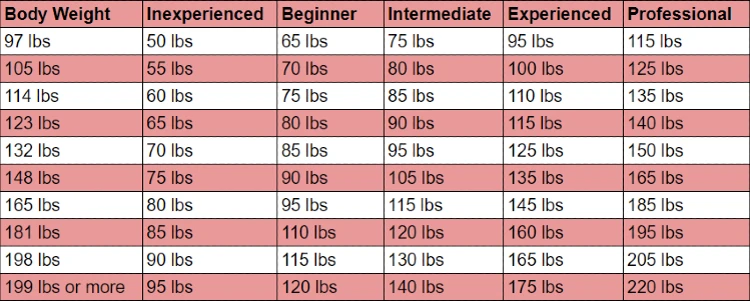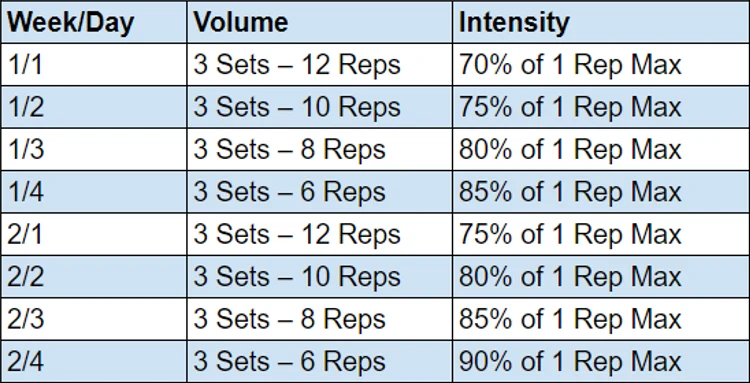
You may wonder about the number of people who can bench 315 pounds or 3 plates.1
Someone benching 315 pounds is a rare occurrence in most commercial gyms, but luckily anyone can see the results compiled by the bench press study below to find out how many people can bench press 315 in the world, in the U.S., and he percent of people who can bench 315 as well.
We’ll also cover how much men and women should bench for their body weight and expertise; in addition to providing a progression timeline and advice to bench more for those looking to bench 315 soon.
So instead of arbitrarily coming up with goals or guessing how many people can bench what, see the results below to figure out how much you should bench, and to see how impressive a 315 bench really is.
Is a 315 Bench Press Impressive? Is a 315 Bench Press Common?
The answer to whether or not a 315 bench press is common is fairly straightforward, while judging if it is impressive depends on several factors. 315 pounds is quite a bit of weight, in fact, that is roughly the weight of a full grown male gorilla.
Being able to bench press this amount of weight is not overly common and cannot be done by a majority of people with or without training.
With that being said, because many in the general public as well as casual gym goers cannot bench press 315 pounds, seeing someone lift that amount of weight is most likely impressive.
However, those well versed in powerlifting and strength training may be harder to awe because they are more familiar with the ins and outs of who is more physically predisposed to be able to lift that amount of weight along with the amount of training it requires.
What Percent of the World Population Can Bench 315 or 3 Plates?
Becoming successful at any sport, including weight lifting or powerlifting, takes practice and access to equipment; considering this, the percentage of the population capable of bench pressing 315 pounds is a significant query.
It’s important to remember that data is constantly changing and its accuracy is based on what information is attainable, so percentages and amounts are estimates based on recent worldwide research.
Although its increasing by the second, according to the United States Census Bureau, the world has reached a population of over 7.9 billion people in 2022.2
Of the 7.9 billion people in the world, there are several subsets of people that should be removed from this number to narrow down the amount of people who are physically capable of lifting 315 pounds.
- Roughly 27% of the world population is under 18; while not completely out of the realm of possibility that someone under the age of 18 could lift 315 pounds, the number is negligible when compared to the world population.
- Females make about 50% of the people in the world. Much like children, there could be women that are capable of lifting 315, but the number is presumably miniscule and shouldn’t make a large difference in the final percentage estimate.
- Males and females over the age of 65 comprise nearly 10% of humans and the extreme majority aren’t able to lift 315 pounds.
To ensure the capable population is accurate, we would remove the 27% for children, 10% for the elderly, and divide the remaining number by 2, which leaves males between the ages of 18-65.
Population of Children:
27% of 7,900,000,000 = 2,133,000,000
Population of Elderly:
10% of 7,900,000,000 = 790,000,000
Population Minus Children and Elderly:
7,900,000,000 – 2,133,000,000 – 790,000,000 = 4,977,000,000
Population Minus Children, Elderly, and Women:
4,977,000,000 / 2 = 2,488,500,000
To find out what percentage of 2,488,500,000 men aged 18 to 65 can bench press 315, it is critical to dive further into how much of the world has the time to dedicate to powerlifting as well as access to proper equipment that aids in training.
The United Nations has divided the world into 3 categories: developed, developing, and underdeveloped.
Developed countries only make up about 15% of the world, leaving the remaining 85% as either developing or underdeveloped.
These 2,115,225,000 people, or 85% of the population, deal with poverty, hunger, malnutrition, low or no access to healthcare, to name just a small portion of the many challenges they face.
Because of living conditions and requirements, this heavily limits the amount of time and effort that could be dedicated to training and doesn’t account for the lack of gym facilities or equipment available.
While it is improbable to assume the 0% of people in underdeveloped or developing countries are capable of bench pressing 315, similar to above when estimating for women and children, it is likely the amount is far below a single percentage point and thus, not statistically significant.
Population Minus Children, Elderly, Women, and Developing/Underdeveloped Countries:
2,488,500,000 – 2,115,225,000 = 373,275,000
This leaves a mere 373,275,000 and of that number, research has shown those utilizing a gym membership makes up less than 22% of the population in developed countries.3
Maximum Amount of Male Gym Members Between 18 and 65:
22% of 373,275,000 = 82,120,500
82,120,500 is approximately 1% of the world’s population. Of that 1%, a majority practice well rounded workouts that involve significant cardio and average to moderate strength training.
This knowledge leads us to safely assume that only a small fraction of 1% of the world’s population can bench press 315 pounds, but the exact number remains unclear.
How Many People in the World Can Bench 315? How Many People Can Bench Press 315 Worldwide?
Deducing how many people worldwide can bench 315 is even more challenging than estimating a percentage, but it does help to know some additional facts about weightlifting.
According to bench press strength standards for men which will be elaborated on further later in this article, the amount of weight capable of being bench pressed is conducive with the amount the lifter weighs.

Source: gilaxia via Canva.com4
There are 5 levels of experience that are broken down by sex and by body weight:
- Inexperienced
- Beginner
- Intermediate
- Experienced
- Professional
Inexperienced, beginners, and intermediate lifters, regardless of weight, most likely will not be able to bench press 315 pounds.
Experienced and professional lifters are those which have at least 2 years of dedicated training make up, at most, 10% of males that work out.
Because experienced and professional lifters abilities are still typically restricted by weight, only about 55% (about 5% of dedicated gym goers) are able to to lift over 300 pounds. Using the numbers from the section above, we can estimate the following:
Maximum Amount of Male Gym Members Between 18 and 65:
22% of 373,275,000 = 82,120,500
Experienced and Professional Level Weightlifters:
10% of 82,120,500 = 8,212,050
Experienced and Professional Level Weightlifters Able To Bench 315:
55% of 8,212,050 = 4,516,627
Therefore, when removing children, women, the elderly, those in underdeveloped countries, and then taking into account the skill level of most lifters and amount of people who have a gym membership, only about 4.5 million (4,516,627) people worldwide can bench 315 pounds.
What Percentage of Americans Can Bench Press 315 Pounds?
The United States is considered a developed country, so many don’t face the same struggles as a majority of the world.
It may seem like the percentage of people who can bench 315 would be significantly higher, but because a majority of experienced and professional lifters worldwide live in developed countries, the percentage is roughly the same and thus, less than 1% of Americans can bench 315 pounds.
If that’s you, congratulations on being in the 1% and if that’s not you, we have some tips below that can help get you there.
How Many Individuals in the US Can Bench 315?
The calculations above concluded that only about 5% of dedicated male gym goers were capable of benching 315, so to pinpoint the amount of people in the United States able to bench 315, the amount of people working out in the US is needed.
In 2019, according to The Global Health and Fitness Association Global Report, 1 in 4 Americans worked out at a gym, so the below would hold true using the percentages in the previous section.5,6
Population of the United States in 2019 That Worked Out at the Gym:
328,300,000 / 4 = 82,075,000
Estimated Population of Males in the United States in 2019 That Worked Out at the Gym:
82,075,000 / 2 = 41,037,500
Experienced and Professional Level Weightlifters Capable of Benching 315:
5% of 41,037,500 = 2,051,875
Therefore, approximately 2 million people in the U.S. can bench 315 pounds.
How Many People Can Bench Press 315 Without Working Out or Lifting Weights?
It’s no surprise that almost no one can bench 315 pounds without regularly working out or lifting weights. From the above information, it is clear that a significant amount of dedication is required to work up to being able to lift that amount of weight.
According to a study in Sports Med Open, heavier people have more muscle mass than those who weigh a standard amount.7
This means there is a small possibility that a large man that weighs over 300 pounds could potentially, with very little training, bench 315 pounds.
However, most men at 300 pounds aren’t very athletic and are overweight so the chances are still slim.
As the amount lifted decreases, the amount of inexperienced lifters with the ability to bench without training increases.
While the number of people who can bench 225 without working out is still relatively small, if someone weighs between 250 and 300, it might still be achievable.

Source: gilaxia via Canva.com8
What Is the Average Amount Both Men & Women Can Bench Press?
As mentioned previously, there are several levels of experience when it comes to weight lifting and the average amount both men and women can bench press is based on experience level as well as weight.
As training continues, getting stronger is inevitable, but will hit a ceiling for both men and women based on body weight.
Bench Press Strength Standards for Men
Men who haven’t set foot in a gym can expect to lift between 50% and 75% of their body weight.
With little practice, these percentages increase to between 65% and 96% and continue at an upward trajectory as training continues.
Bench Press Averages & Strength Standards for Men

Bench Press Strength Standards for Women
Research has found that women lift about 69% to 78% of males, so it makes sense that an inexperienced female is able to bench between 47% and 50% of their body weight.9
However, just like their male counterpart, with little training, those percentages increase to between 60% and 67% and continue to rise as experience is gained.

Source: South_agency via Canva.com10
Bench Press Averages & Strength Standards for Women

How Much Time Will It Typically Take for Most People To Bench Press 315 Pounds? (Bench Press Progression Timeline)
Throughout this article, it’s evident that bench pressing over 300 pounds isn’t an overnight achievement. Therefore, the transition from a starting strength routine to a 315-pound bench press will likely take some time for most individuals.
Some lifters may never be capable of reaching 315, but regardless, reaching an individual bench press max is achieved in the same way.
Bench Press Progression Timeline
- Inexperienced to Beginner: 1 month of consistent training to reach about 85% of bodyweight – A 200 pound male should increase weight from approximately 135 to 175.
- Beginner to Intermediate: 6 months of training consistently to reach between 100% to 115% of bodyweight – A 200 pound male should increase lifted weight from 175 to 215.
- Intermediate to Experienced: 2 years of training to reach roughly 140% of bodyweight – A 200 pound male may be able to lift up to 290 pounds.
- Experienced to Beyond: 3 to 4 years of training can push lifters beyond 150% of bodyweight – A 200 pound male may be able to lift 315 pounds or more.11
Expert Practical Advice To Achieve a 315 Bench (Tips To Reach 3 Plate Bench Press)
If a 315 bench press is the ultimate goal, following expert advice to achieve it can help in reaching milestones faster.
The below tips to reach a 3 plate bench press are helpful to anyone looking to increase their load and progress faster.
1. Make Benching a Priority
If the goal is to lift more, lifting more frequently is required. Studies have found that increasing weekly volume increases strength gains.
While this can be done in a schedule of benching for only 1 day per week, additional research shows that spreading volume out over 4 days is more beneficial.12,13
2. Vary Reps with Daily Undulating Periodization (DUP)
Daily Undulating Periodization helps the body not become accustomed to a specific workout routine by varying volume and intensity on a daily basis and promotes hypertrophy, strength gains, and can prevent plateaus.14
The chart below is an example of what volume and intensity changes would look like using DUP.

3. Supplemental Exercises
While it is important to focus work on the bench press, additional exercise focusing on smaller muscle groups that will support the pectoral, deltoid, biceps, and triceps will push lifters toward strength gains.
These accessory exercises include:
- Push Ups
- Dips
- Overhead Press
- Incline Dumbbell Press
4. Focus On & Improve Form
If technique is off, incorrect muscle groups will be utilized and chances are, strength gains will be slow, goals won’t be met, and the chance of injury increases.
Correct grip, foot placement, and the arch of the back are all equally important and can catapult a lifter into progress.15
5. Utilize a Spotter
Lifting heavy can be dangerous, so it is critical to have a spotter ensuring safety.
Having the peace of mind that a safeguard in place allows the lifter to focus on form and pushing themselves toward finishing their sets.

Source: Rido via Canva.com16
6. Eat In a Caloric Surplus
Food provides energy and to build muscle and/or strength, eating enough calories as well as protein is of utmost importance.
In general, strength goes up in a caloric surplus and goes down slightly during a cut or while in a caloric deficit so use this to your advantage by pushing harder when bulking, and not being down and out on yourself for losing some strength while dieting.
The bench press is a common workout seen at the gym and thus, is one of the major lifts that’s often used to gauge or judge how strong someone is.
Approximately 4.5 million people worldwide, including about 2.5 million in the U.S., can bench press 315 pounds. To reach the top 1%, consistency and persistence are crucial. Keep following the tips above to achieve the elusive 3-plate bench press.
Frequently Asked Questions
Is Bench Pressing Over 135+ Lbs A Lot?
The amount one can bench press is relative to weight and sex; so, while a male weighing 200 pounds can most likely bench press 135 with no training or experience, it may take 6 months of training for a man weighing 115 to bench press that same amount, but a majority of women will never be able to reach that goal.
How Many People Can Bench Press 135?
Bench pressing 135 pounds is attainable to about 90% of men weighing over 150 pounds with very little practice. However, a majority of women, unless around 200 pounds, can’t bench press 135 until they reach experienced or professional level if their weight allows it, which would only leave about 5% of females that are gym goers.
How Many Individuals Can Bench Press 225 Pounds?
A 225 pound bench press is more attainable than 315 pounds and around 581 million people worldwide are capable of that achievement.
References
1South_agency. Canva. Accessed 15 April 2023. <https://www.canva.com/photos/MAEIxJR_zOo-bench-press-training/>
2United States Census Bureau. (2022). Population Clock: World. U.S. Census Bureau. Retrieved December 1, 2022, from <https://www.census.gov/popclock/world>
3Rizzo, N. (2021, October 12). 200+ Gym Industry Statistics 2021 [Global Analysis]. RunRepeat. Retrieved December 2, 2022, from <https://runrepeat.com/gym-industry-statistics>
4gilaxia. Canva. Accessed 15 April 2023. <https://www.canva.com/photos/MAEJMMj9sEs-bench-pressing-/gilaxia. Canva. Accessed 15 April 2023.>
5The Global Health & Fitness Association. (2020). The 2020 IHRSA Global Report. IHRSA. Retrieved December 2, 2022, from <https://www.ihrsa.org/publications/the-2020-ihrsa-global-report/>
6Galic, B. (2021, September 11). 113 Gym Membership Statistics You Need to Know. Livestrong.com. Retrieved December 2, 2022, from <https://www.livestrong.com/article/13767109-gym-membership-statistics/>
7Hoor, G., Plasqui, G., Schols, A., & Kok, G. (2018, March 1). A Benefit of Being Heavier Is Being Strong: a Cross-Sectional Study in Young Adults. NCBI. Retrieved December 2, 2022, from <https://www.ncbi.nlm.nih.gov/pmc/articles/PMC5833324/>
8gilaxia. Canva. Accessed 15 April 2023. <https://www.canva.com/photos/MAEJNOjXW8A-bench-press-workout-/>
9Brzycki, M. (2002). Gender Differences in Strength: A Comparison of Male and Female World-Record Performances in Powerlifting. Men v Women. Retrieved December 2, 2022, from <https://scholar.princeton.edu/sites/default/files/brzycki/files/mb-2002-01.pdf>
10South_agency. Canva. Accessed 15 April 2023. <https://www.canva.com/photos/MAEJesZEBiI-beautiful-young-woman-bench-press-training-in-gym/>
11McKay, K. (2021, August 5). How Much Ya Bench? Strength Benchmarks for Men. The Art of Manliness. Retrieved December 2, 2022, from <https://www.artofmanliness.com/health-fitness/fitness/strength-benchmarks-for-men/>
12Ralston, G., Kilgore, L., Wyatt, F., & Baker, J. (2017, December). The Effect of Weekly Set Volume on Strength Gain: A Meta-Analysis. PubMed. Retrieved December 2, 2022, from <https://pubmed.ncbi.nlm.nih.gov/28755103/>
13Ethier, J., & Nuckols, G. (2020, January 18). The FASTEST Way To Increase Your Bench Press (3 Science-Based Tips). Built With Science. Retrieved December 2, 2022, from <https://builtwithscience.com/fitness-tips/how-to-increase-bench-press/>
14Israetel, D. M. (2020, September 30). Is Periodization Important? YouTube. Retrieved December 2, 2022, from <https://www.youtube.com/watch?v=OuG-gvFtSgU>
15Bumgardner, T., Staley, C., Hansen, S., Hyght, C., & Bach, E. (2017, June 7). Tip: The 5 Bench Press Commandments. T-Nation. Retrieved December 2, 2022, from <https://www.t-nation.com/training/tip-the-5-bench-press-commandments/>
16Rido. Canva. Accessed 15 April 2023. <https://www.canva.com/photos/MACV1xKu8G8-man-doing-bench-press/>